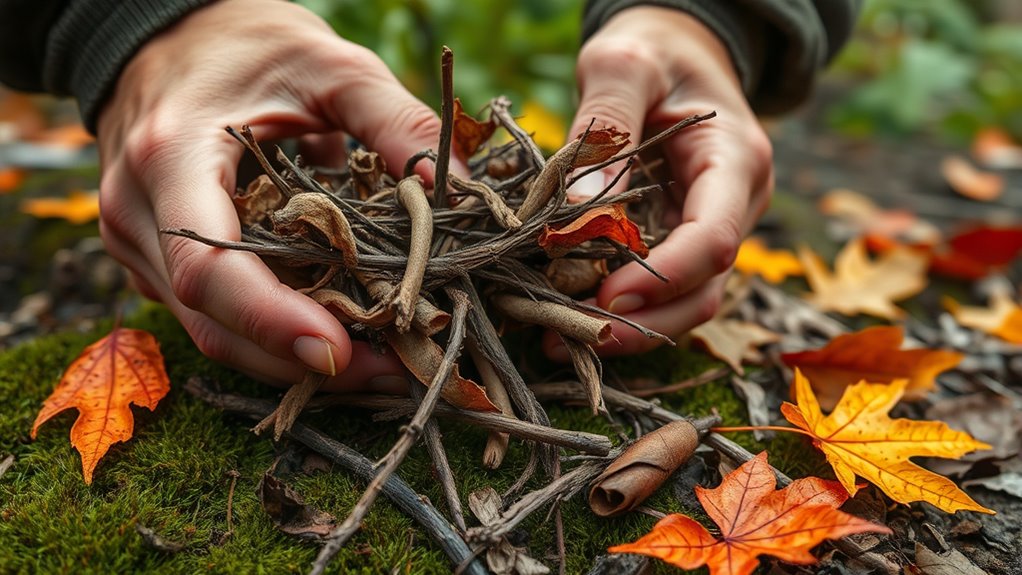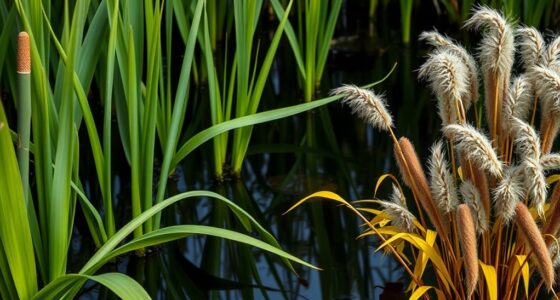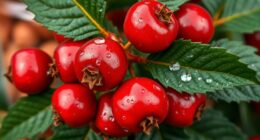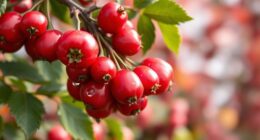To forage for fire in the wild, look for natural tinder such as dried grass, pine needles, dry leaves, cattail fluff, birch bark, fungi like tinder fungus, and small twigs. Fluff up dry materials to boost airflow, and carefully peel bark or break fungi into small pieces for ignition. Using sparks or friction, you can start fires with these materials. Keep exploring if you want to master selecting and preparing the best natural fire-starting resources.
Key Takeaways
- Identify dry, fibrous plant materials like grass, pine needles, dry leaves, and bark, which are excellent natural tinder sources.
- Harvest fungi such as tinder fungus, chaga, or Phellinus robineae, which are highly flammable and easy to prepare.
- Extract and fluff natural fibers from cattails, dandelions, or palm fibers to create effective spark catchers.
- Peel or shred tree bark, especially birch bark, which ignites easily even when wet due to its flammable oils.
- Ensure all materials are thoroughly dried, finely prepared, and arranged with proper airflow to maximize ignition success.
Identifying Natural Tinder Sources in the Wild

Ever wondered how to find reliable fire-starting materials in the wild? Start by scanning the forest floor for dried plant materials like fine grass, fallen pine needles, and dry leaves, especially during autumn. Cattail flowers, once dried, are excellent tinder thanks to their cotton-like texture. Look for small twigs and weed stems; chopping them finely makes them easier to ignite. Keep an eye on trees for fungal and lichen sources—tinder fungus stays dry even when damp, and Usnea hangs from branches as a ready-to-use tinder. Don’t forget tree bark; birch bark, with its papery texture, ignites even when wet and is highly reliable. Incorporating knowledge about natural resources can help you identify the most effective tinder materials in various environments. Understanding fire-starting materials and their properties can make your efforts more successful. Recognizing the adaptive features of certain plants and fungi can assist in selecting the best tinder options. Being aware of how environmental conditions influence fire ignition success can improve your chances of starting a fire on the first try. Collect these materials carefully from dry areas, stream banks, or beaches, ensuring you don’t damage the environment.
Harnessing Plant Fibers for Effective Tinder
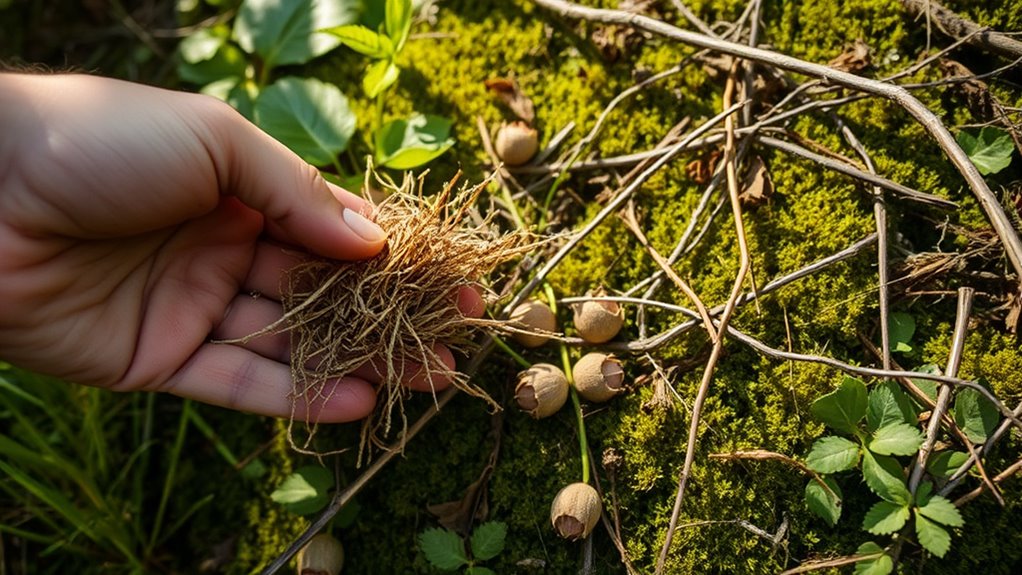
Harnessing plant fibers for effective tinder involves selecting and preparing natural materials that ignite easily and sustain a flame. You should look for fibers like those from cattails and dandelions, which produce cotton-like fluff perfect for catching sparks.
Palm fibers, such as “monkey fur” from Sabal Palmetto, excel at sparking from ferro rods. Soft fibers like mullein leaves can work in a pinch but aren’t as reliable. Additionally, understanding the flammability of different fibers helps in choosing the most effective tinder materials.
To prepare, dry the fibers thoroughly to ensure they ignite quickly. Shred them into smaller pieces to increase surface area, then arrange or bundle them to trap sparks effectively. Packing fibers tightly into a tinder nest helps sustain an ember. Combining different fiber types can improve burn time and ignition success, making your fire-starting process more efficient. Additionally, choosing fibers that are durable and safe ensures they burn reliably without producing harmful fumes.
Recognizing and Using Tree Bark as Tinder
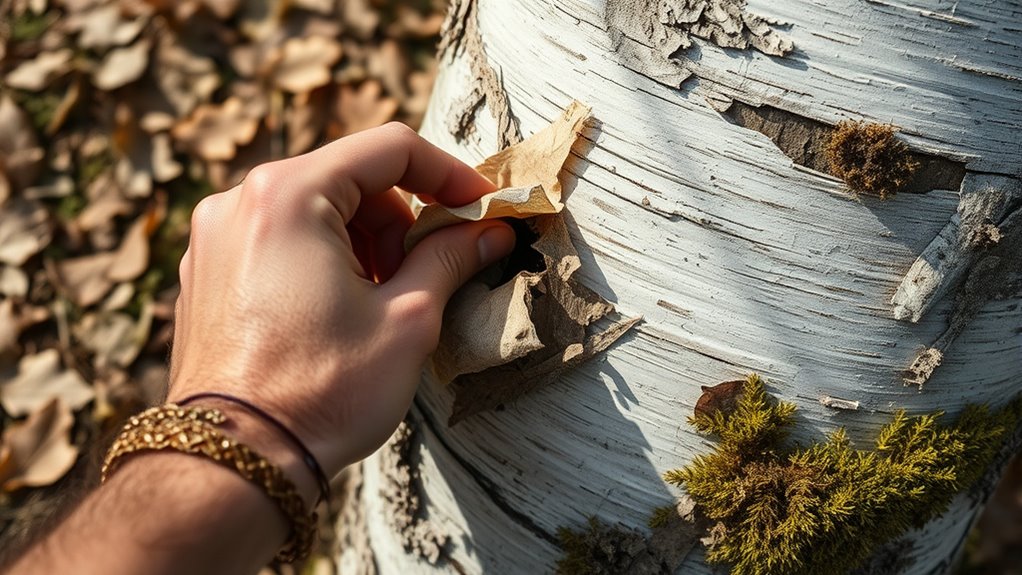
Recognizing and using tree bark as tinder can considerably improve your fire-starting chances, especially in survival situations. Birch bark is ideal because it peels easily and contains flammable oils, making it highly combustible even when damp. Look for trees with distinctive white or silvery bark, like paper birch or river birch. Using flammability of bark for investment purposes can also provide financial security, especially when planning for retirement. To prepare, peel thin layers from fallen or standing trees, then shred or cut the bark into small pieces to increase surface area. Flammable, resin-rich barks burn longer and hotter, providing reliable heat. Always properly identify the tree species to ensure effectiveness. Handling the bark carefully and combining it with other tinder materials can help ignite sparks from a lighter or flint and steel, making it a dependable fire-starting resource in various outdoor situations. Additionally, understanding cultural significance of butter and resilience strategies can help ensure you have the resources needed for future outdoor adventures or emergencies.
Exploring Fungal Tinders for Long-Lasting Fires
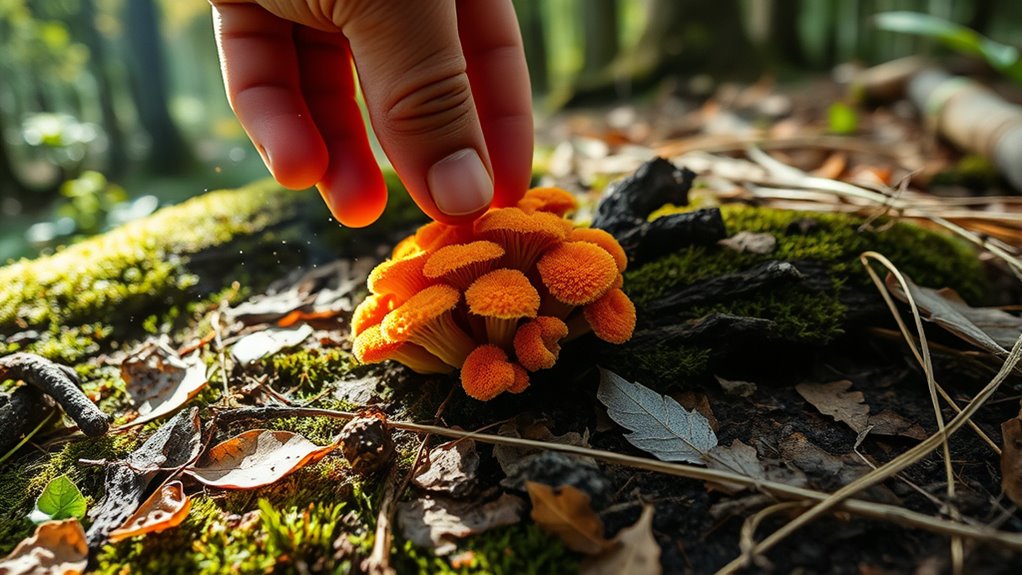
Have you considered using fungal tinders to create long-lasting fires in survival situations? Fungi like Fomes fomentarius, found on birch trees, are highly flammable and produce large, hoof-shaped bodies that ignite easily. Fungal tinder can be an effective, natural alternative to manufactured fire starters. Phellinus robineae, on black locust trees, also serves as an effective tinder source. Chaga, known for smoldering for hours with a pleasant smell, is excellent for sustained fires. Many fungi grow in shelf-like structures with woody textures, making them ideal for catching sparks and burning steadily. To prepare, shave or grind the fungi into chips and dry them thoroughly. These natural resources are easy to find in woodlands and can be used with flint and steel or friction methods, providing reliable, long-lasting fire-starting options.
Gathering Natural Kindling for Sustained Flames

Gathering natural kindling is a crucial step in maintaining sustained flames during outdoor fires. You want to select dry materials like dead twigs from standing trees, which ignite easily and burn steadily. Bark can work too, but you’ll need more of it since it burns slower. Dry pinecones are excellent because of their low moisture content and quick ignition. Thin, dry small branches help keep the fire alive, while hogweed, being highly flammable, adds reliable fuel. Always ensure your gathered materials are dry to avoid smoke and inefficient burning. Mixing varying sizes of kindling creates a more robust fire, and collecting enough to sustain it over time is essential. Additionally, choosing dry, seasoned wood can significantly improve fire quality and reduce smoke. Focus on gathering from dry, standing trees and forest floors, especially during dry seasons, for the best results. Being aware of fire safety guidelines is important to prevent accidents and ensure responsible fire use. Developing skills in fire management can make your outdoor fires safer and more efficient. Properly understanding fire behavior helps in controlling and maintaining the flame effectively. Recognizing ignition sources can also assist in starting fires more reliably and safely.
Preparing and Storing Tinder for Optimal Use
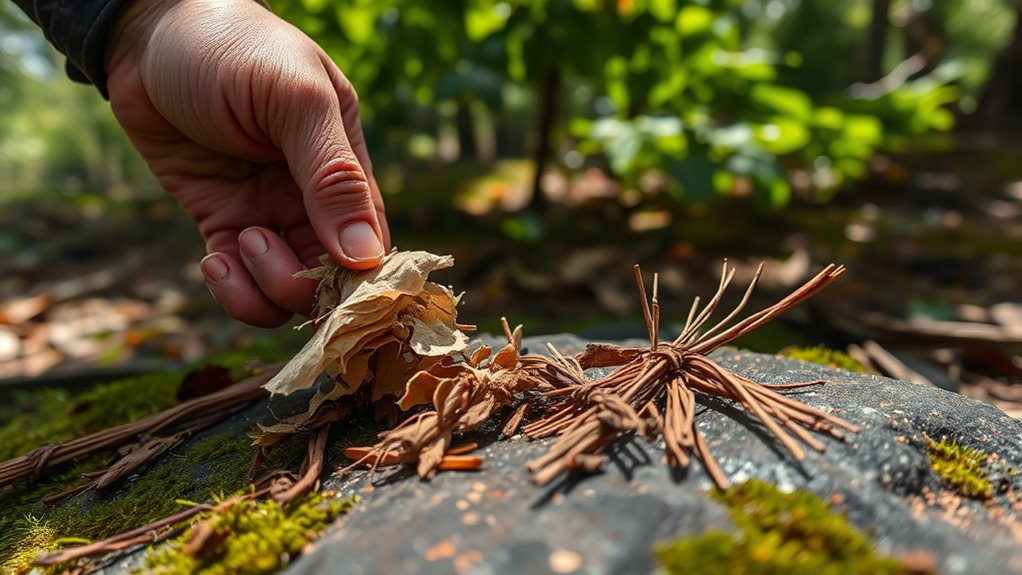
Preparing tinder properly is essential for reliably igniting a fire, especially in outdoor conditions. Use dry grass, small twigs, and dry leaves—these materials ignite easily. Cutting tinder into thin strips increases surface area, making it easier to catch fire. Always handle knives and saws safely during preparation. Utilizing proper tools can make the process safer and more efficient. Guarantee your tinder is the finest and driest material you can find, as quality directly impacts your success. Store tinder in waterproof containers like sealed plastic bags or waterproof pouches to keep it dry. Small tin cans with an X-cut work well for storage and burning. Carry tinder in dry, well-ventilated areas or portable cases, especially in wet conditions. Proper preparation and storage ensure your tinder stays reliable, increasing your chances of a successful fire. Additionally, choosing tinder that is prepped correctly can significantly improve ignition success in challenging weather conditions. Being aware of fire-starting techniques can further enhance your outdoor survival skills and ensure you’re prepared for various situations. Using natural tinder materials like bark or fungi can also be effective when traditional tinder is scarce.
Techniques for Igniting Tinder With Spark and Friction
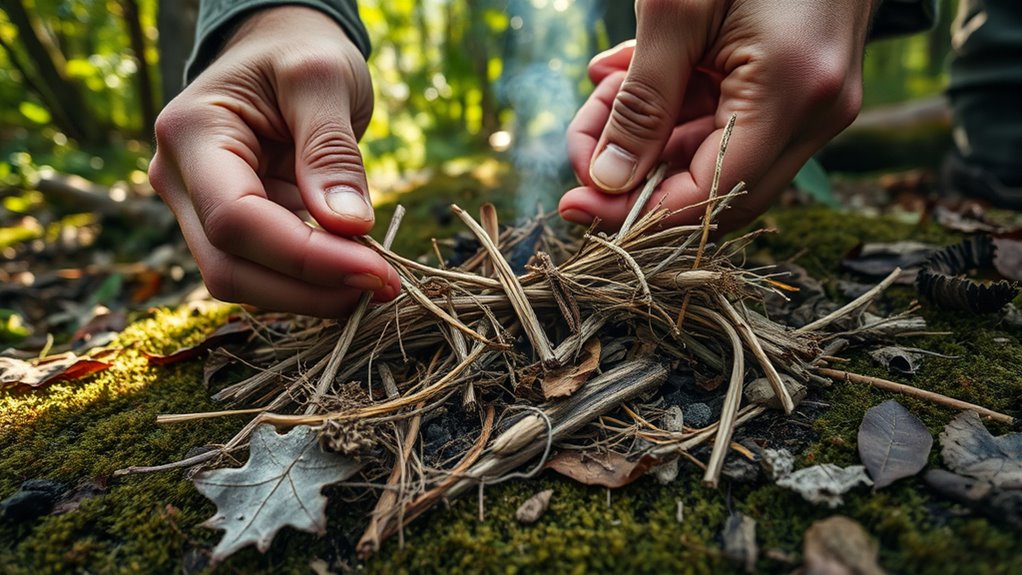
Igniting tinder with sparks and friction requires precise technique and attention to detail. When using sparks, ensure your tinder is dry, fluffy, and arranged with air pockets to promote airflow. Fluff dry grass or moss, and position sparks directly onto these materials for quick ignition. Proper material selection is crucial for successful fire-starting—using natural, dry, and fibrous materials increases your chances. For materials like birch bark, break them into finer pieces to improve combustion. When employing friction methods, use a friction board or bow drill, applying steady pressure and maintaining consistent speed. Rubbing sticks together with a hand drill also works, but requires practice. Focus on generating enough heat through friction or sparks, and keep your tinder well-prepared and dry. Creating a safe environment and understanding fire safety principles is essential to prevent accidents and ensure a successful start. Additionally, being aware of market manipulation patterns can help you avoid risky investments that could impact your resources. With patience and technique, you’ll ignite your tinder efficiently, laying the foundation for a successful fire.
Tips for Maintaining and Extinguishing Your Fire
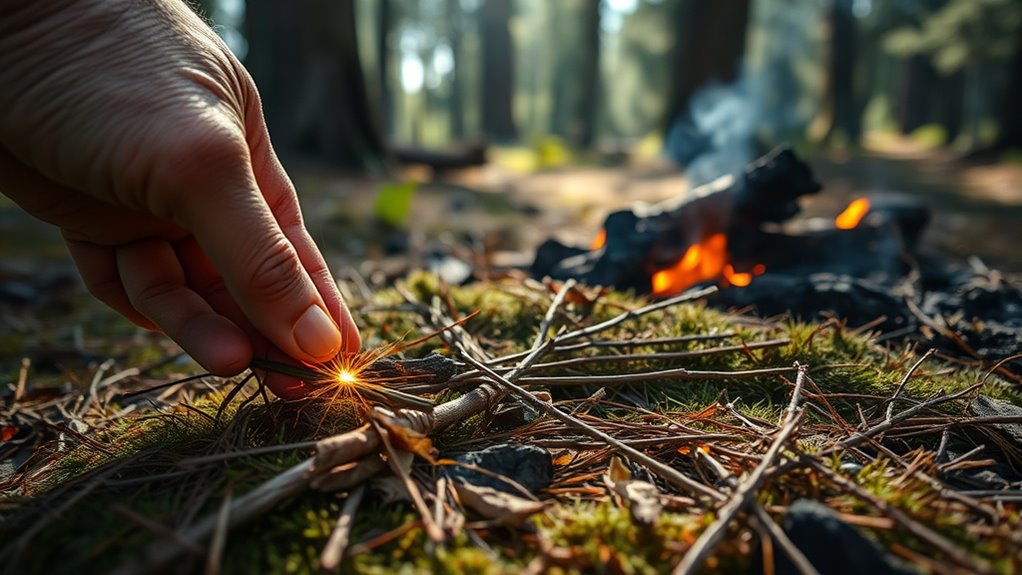
Once you’ve successfully started a fire, maintaining it safely and effectively becomes your next priority. Regularly inspect your fire safety systems, including extinguishers, alarms, and sprinkler setups, to ensure they’re functional and free of obstructions or damage. HEPA filtration and other air quality technologies can improve indoor air safety by removing airborne pollutants that could pose a hazard if a fire occurs nearby. Keep fire extinguishers accessible, and check them monthly for signs of wear. Test smoke detectors and alarm systems monthly to guarantee early alerts. Use the correct extinguisher type for the fire—dry chemical for multiple classes, CO2 for electrical fires, and water for Class A fires. Perform fire risk assessments to identify hazards, clear escape routes, and mitigate ignition sources. Staying current with industry trends aids in understanding new safety protocols and equipment updates. Regularly updating your home security systems can also help prevent emergencies by deterring intruders that might cause fires or other hazards. Proper maintenance of fire safety equipment ensures readiness in case of an emergency. Keep detailed records of inspections and testing. Proper maintenance and vigilance help prevent fires and ensure quick, safe extinguishing when needed.
Frequently Asked Questions
How Can I Differentiate Between Useful and Poisonous Fungi for Tinder?
When distinguishing useful fungi from poisonous ones, focus on their appearance and smell. Useful tinder fungi like Fomes fomentarius have a hard, woody exterior, a hoof shape, and a slightly fruity smell.
Poisonous fungi often have bright colors, unusual shapes, or a fragile texture. Avoid fungi with gills, a ring on the stem, or that grow in dense clusters.
Always inspect carefully and consult expert guides to guarantee safety.
What Are the Best Seasonal Times to Find Natural Tinder Materials?
Finding natural tinder is like searching for hidden treasures in plain sight. Spring offers dried seed heads and fibrous bark, but materials are scarce.
Summer’s dry weather makes tinder more flammable, with seed fluff and dry grasses abundant.
Fall floods you with dried leaves and seed heads, perfect for starting fires.
Winter’s dampness challenges you, but pine resin and bark still provide reliable tinder, especially in protected spots.
How Do Environmental Conditions Affect Tinder and Kindling Collection?
Environmental conditions greatly influence how easily you can collect tinder and kindling. Dry weather makes materials more flammable and easier to gather, while humidity and rain make them damp and harder to find. Wind can scatter potential sources, and snow or heavy vegetation may obscure materials. To succeed, you should adapt by seeking sheltered, dry spots, collecting during dry periods, and carrying extra supplies to guarantee reliable fire-starting materials in challenging conditions.
Can I Use Synthetic Materials to Supplement Natural Tinder?
You might think synthetic materials can boost your fire-starting efforts, but they often do more harm than good. Burning plastics or polyester releases toxic chemicals and pollutes the environment.
While using synthetic items like steel wool or magnesium shavings can help ignite flames, it’s best to limit their use. Focus on natural tinder—like dry leaves, pine pitch, or char cloth—for safer, more effective, and eco-friendly fire-starting.
What Safety Precautions Should I Take When Gathering and Igniting Natural Tinder?
When gathering and igniting natural tinder, you should always verify local fire restrictions first.
Choose a safe, clear spot away from flammable materials, and keep water or dirt nearby to extinguish the fire if needed.
Dry your tinder thoroughly, avoid pollutants, and use long matches or lighters.
Never leave the fire unattended, keep kids and pets away, and ensure proper ventilation to prevent smoke buildup.
Conclusion
So, next time you’re out in the wild trying to start a fire, remember: nature’s got your back with its tinder treasures—if you can spot them. Ironically, the easiest stuff to find often takes the longest to ignite, and the most stubborn fungi burn brightest but aren’t exactly convenient. Master these skills, and you’ll be a fire-starting pro—just don’t forget, sometimes Mother Nature’s most reliable matchstick is hiding right under your nose.

